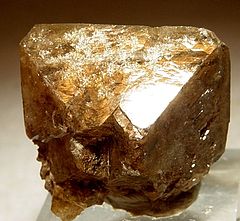- Mellite
-
Mellite 
MelliteGeneral Category Organic compounds Chemical formula Al2[C6(COO)6]·16H2O Strunz classification 10.AC.05 Crystal symmetry Tetragonal (4/m 2/m 2/m) ditetragonal dipyramidal Unit cell a = 15.53 Å, c = 23.19 Å; Z = 8 Identification Color Honey-yellow, deep red, pale shades of red, brown, gray, white; Crystal habit Elongated bipyramidal prismatic; as nodules and coatings, fine-grained massive Crystal system Tetragonal Cleavage poor/indistinct on {023} Fracture conchoidal Tenacity Slightly sectile Mohs scale hardness 2-2½ Luster Vitreous, resinous, greasy Streak White Diaphaneity Transparent to translucent Specific gravity 1.64 Optical properties Uniaxial (-) may be anomalously biaxial Refractive index nω = 1.539 nε = 1.511 Birefringence δ = 0.028 Pleochroism Weak; O = yellowish brown; E = yellow Ultraviolet fluorescence Pale yellow to blue (LW & SW UV) Other characteristics Pyroelectric References [1][2][3] Mellite, also called honeystone, is an unusual mineral being also an organic chemical. Chemically identified as an aluminium salt of mellitic acid; that is, aluminium benzene hexacarboxylate hydrate, with the chemical formula Al2C6(COO)6·16H2O.[3]
It is a translucent honey-coloured crystal which can be polished and faceted to form striking gemstones. It crystallizes in the tetragonal system and occurs both in good crystals and as formless masses. It is soft with a Mohs hardness of 2 to 2.5 and has a low specific gravity of 1.6.[3][1]
It was discovered originally in 1789 at Artern in Thuringia in Germany it has subsequently also been found in Russia, Austria, the Czech Republic, and Hungary. It was named from the Greek μέλ˘ι, "melis" for honey, in allusion to its color.[2]
It is found associated with lignite and is assumed to be formed from plant material with aluminium derived from clay.[1]
References
- ^ a b c http://rruff.geo.arizona.edu/doclib/hom/mellite.pdf Handbook of Mineralogy
- ^ a b http://www.mindat.org/min-2638.html
- ^ a b c http://webmineral.com/data/Mellite.shtml Webmineral data

This article about a specific mineral or mineraloid is a stub. You can help Wikipedia by expanding it.
